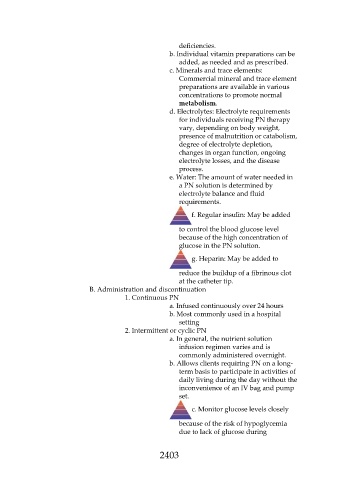Page 2403 - Saunders Comprehensive Review For NCLEX-RN
P. 2403
deficiencies.
b. Individual vitamin preparations can be
added, as needed and as prescribed.
c. Minerals and trace elements:
Commercial mineral and trace element
preparations are available in various
concentrations to promote normal
metabolism.
d. Electrolytes: Electrolyte requirements
for individuals receiving PN therapy
vary, depending on body weight,
presence of malnutrition or catabolism,
degree of electrolyte depletion,
changes in organ function, ongoing
electrolyte losses, and the disease
process.
e. Water: The amount of water needed in
a PN solution is determined by
electrolyte balance and fluid
requirements.
f. Regular insulin: May be added
to control the blood glucose level
because of the high concentration of
glucose in the PN solution.
g. Heparin: May be added to
reduce the buildup of a fibrinous clot
at the catheter tip.
B. Administration and discontinuation
1. Continuous PN
a. Infused continuously over 24 hours
b. Most commonly used in a hospital
setting
2. Intermittent or cyclic PN
a. In general, the nutrient solution
infusion regimen varies and is
commonly administered overnight.
b. Allows clients requiring PN on a long-
term basis to participate in activities of
daily living during the day without the
inconvenience of an IV bag and pump
set.
c. Monitor glucose levels closely
because of the risk of hypoglycemia
due to lack of glucose during
2403

